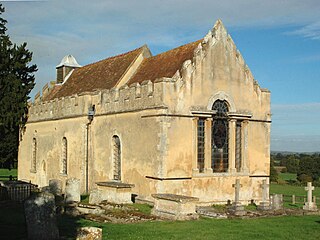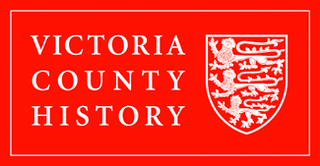Family
Sir Thomas was the eldest son of John Tipping of Wheatfield, Oxfordshire and his wife, Anne daughter of Sir Christopher Pigott of Doddershall in Buckinghamshire. He was baptised in Wheatfield parish church on 10 December 1615, but his father died when he was only four years old. In 1627, Tipping inherited the Wheatfield estate upon the death of his grandfather, Sir George Tipping. Four years later, he matriculated from Trinity College, Oxford at the age fifteen. He married, in 1637, Elizabeth (1620–1698) youngest daughter and co-heiress of Sir White Beconshaw of Moyles Court at Ellingham, Hampshire, by whom he had five sons and eleven daughters, only eight of whom survived him.

Wheatfield is a civil parish and deserted medieval village about 4 miles (6.4 km) south of Thame in Oxfordshire.
Sir Christopher Pigott was an English politician, Member of Parliament for Buckinghamshire from 1604 to 1607.

Buckinghamshire, abbreviated Bucks, is a county in South East England which borders Greater London to the south east, Berkshire to the south, Oxfordshire to the west, Northamptonshire to the north, Bedfordshire to the north east and Hertfordshire to the east.
Career
From 1647, Tipping served on various local Oxfordshire commissions. Although sometimes referred to as a Royalist who walked a tightrope during the Civil War, Tipping, in fact, appears to have been something of a Parliamentarian like his more outspoken uncle, the Puritan and Parliamentarian writer, William 'Eternity' Tipping. Thomas was brother-in-law of the regicide, Sir John Lisle, and a friend of the Commonwealth Lord Keeper of the Great Seal, Sir Bulstrode Whitelocke, whose visits to Wheatfield are recorded in his diary. However, upon the Restoration, he embraced reconciliation and Charles II created him a Knight Bachelor at Whitehall Palace on 15 June 1660. To commemorate this event portraits were painted of Sir Thomas and Lady Tipping by Gilbert Soest. Both, for many years, hung in Bramshill House in Hampshire, home of their descendants, the Cope family. The former is now in the Tate Gallery. The whereabouts of the latter is unknown.

The term Cavalier was first used by Roundheads as a term of abuse for the wealthier Royalist supporters of King Charles I and his son Charles II of England during the English Civil War, the Interregnum, and the Restoration. It was later adopted by the Royalists themselves. Although it referred originally to political and social attitudes and behaviour, of which clothing was a very small part, it has subsequently become strongly identified with the fashionable clothing of the court at the time. Prince Rupert, commander of much of Charles I's cavalry, is often considered to be an archetypal Cavalier.
William Tipping (1599–1649) was an early 17th-century English religious writer.
The broad definition of regicide is the deliberate killing of a monarch, or the person responsible for the killing of a person of royalty.
Sir Thomas died on 1 March 1693, aged 78, and was buried at Wheatfield. He was succeeded in his estates by his second son, Sir Thomas Tipping, 1st Baronet.
Sir Thomas Tipping was a late 17th-century English baronet and Member of Parliament.
This page is based on this
Wikipedia article Text is available under the
CC BY-SA 4.0 license; additional terms may apply.
Images, videos and audio are available under their respective licenses.
Lieutenant-General Harry Mordaunt was an English soldier and politician who sat in the House of Commons between 1692 and 1720.

Sir John St John, 1st Baronet of Lydiard Tregoze in the English county of Wiltshire, was a Member of Parliament and prominent Royalist during the English Civil War. He was created a baronet on 22 May 1611.
John Scudamore, 1st Viscount Scudamore was an English diplomat and politician who sat in the House of Commons at various times between 1621 and 1629. In 1628 he was created Viscount Scudamore in the Irish peerage.
Sir Thomas Penyston, 1st Baronet (1591–1644) was a 17th-century member of the gentry who received one of the first baronetcies. In 1637 he was sheriff of Oxfordshire and in 1640, he was a member of parliament for Westbury.
Katherine FitzGerald, suo jure Viscountess Grandison, was a wealthy Irish heiress, being the only child of Sir John FitzGerald of Dromana, County Waterford. She inherited the Dromana estate in 1664 upon the death of her father. She was married three times; firstly to John Le Poer, 2nd Earl of Tyrone; secondly to Brigadier-General, Hon. Edward FitzGerald-Villiers; and thirdly and lastly to General William Steuart.
Richard Norton of Southwick Park, was an English landowner and politician who sat in the House of Commons at various times between 1645 and 1691. He was a colonel in the parliamentary army in the English Civil War and for a time he commanded the Parliamentary forces besieging Basing House. He was Governor of Portsmouth for Parliament during the Civil War and for Charles II after the Restoration.
The Tipping Baronetcy, of Wheatfield in the County of Oxford, was a title in the Baronetage of England. It was created on 24 March 1698 for Thomas Tipping, Member of Parliament for Oxfordshire and Wallingford. He was the second son of Sir Thomas Tipping and the great-nephew of the religious writer William 'Eternity' Tipping. The title became extinct on the death of the second Baronet in 1725.
Bernard Gardiner was an academic at the University of Oxford, serving as Warden of All Souls College, Oxford, and also as Vice-Chancellor of Oxford University.
Unton Croke was an English judge and politician who sat in the House of Commons in 1628 and 1640. He supported the Parliamentarian cause during the English Civil War.
Sir Henry Wallop was an English politician who sat in the House of Commons variously between 1597 and 1642.
Thomas Moore of Hawkchurch, Dorset was an English politician who sat in the House of Commons variously between 1640 and 1685. He supported the Parliamentarian side in the English Civil War.
John Kempe was an English politician who sat in the House of Commons from 1640 to 1652. He supported the Parliamentarian cause in the English Civil War.
George Lowe was an English politician who sat in the House of Commons at various times between 1640 and 1679. He was an equivocal supporter of the Royalist cause in the English Civil War.

John Bampfield of Poltimore and North Molton, Devon, England, was a Member of Parliament for Tiverton in Devon (1621) and for the prestigious county seat of Devon (1628-9).
Sir Daniel Norton was an English landowner and politician who sat in the House of Commons at various times between 1621 and 1629.

Sir William Whitelock KC was an English Tory gentleman, barrister, and Member of Parliament. His name is also spelt Whitelocke and Whitlock.
Robert Sawyer Herbert of Highclere, Hampshire, was a British politician who sat in the House of Commons for 46 years from 1722 to 1768.








